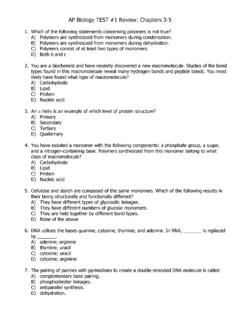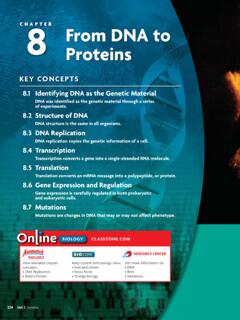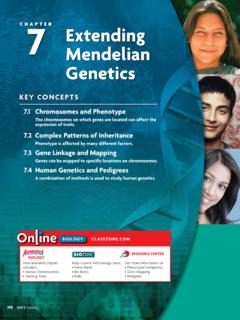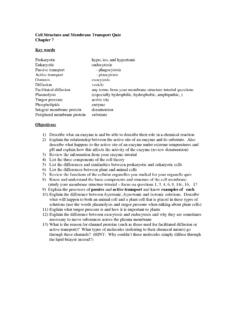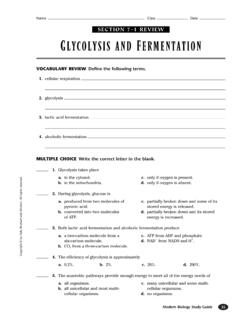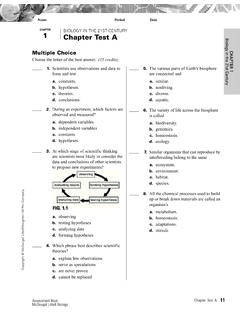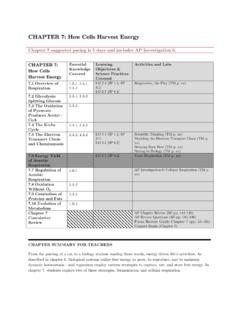Transcription of AP Biology TEST #3 - Chapters 11 & 12 - REVIEW SHEET
1 Page 1 AP Biology TEST #3 - Chapters 11 & 12 - REVIEW SHEET 1. Which of the following is true of mitosis? A) The chromosome number in the resulting cells is halved. B) DNA replication is completed prior to the beginning of this phase. C) The chromosome number of the resulting cells is the same as that of the parent cell. D) Both b and c 2. Which of the following is true of meiosis? A) The chromosome number in the resulting cells is halved. B) DNA replication occurs before meiosis I and meiosis II. C) The homologs do not pair during prophase I. D) The chromosome number of the resulting cells is the same as that of the parent cell.
2 3. Which of the following is true of kinetochores on mitotic chromosomes? A) They are located at the centromere of each chromosome. B) They are the sites where microtubules attach to separate the chromosomes. C) They are organized so that there is one per sister chromatid. D) All of the above 4. Which of the following is true of the mitotic spindle? A) It is composed of actin and myosin microfilaments. B) It is composed of kinetochores at the metaphase plate. C) It is composed of microtubules, which help separate the chromosomes to opposite poles of the cell. D) It originates only at the centrioles in the centrosomes.
3 5. Imagine that there is a mutation in the Cdk2 gene such that its gene product is nonfunctional. What kind of effect would this mutation have on a mature red blood cell? A) The cell would be unable to replicate its DNA. B) The cell would not be able to enter G1. C) The cell would be unable to reproduce itself. D) There would be no effect, because mature red blood cells do not enter the cell cycle. 6. Imagine that there is a mutation in the Cdk2 gene such that its gene product is nonfunctional. What kind of effect would this mutation have on a mammalian white blood cell? A) The cell would be unable to replicate its DNA.
4 B) The cell would be unable to enter G1. C) The cell would be unable to reproduce itself. D) Both a and c 7. Which of the following is true of chromatids? A) They are replicated chromosomes still joined together at the centromere. B) They are identical in mitotic chromosomes. C) They are identical in meiotic chromosomes. D) Both a and b 8. Chromosome movement during anaphase is the result of A) the molecular motors at the kinetochores that move the chromosomes toward the poles. B) molecular motors at the centrosome that pull the microtubules toward the poles. C) shortening of the microtubules at the centrosome that pull the chromosomes toward the poles.
5 D) Both a and c Page 2 9. The difference between asexual and sexual reproduction is A) asexual reproduction only occurs in bacteria, and sexual reproduction occurs in plants and animals. B) asexual reproduction results in an organism that is identical to the parent, whereas sexual reproduction results in an organism that is not identical to either parent. C) asexual reproduction results from the fusion of two gametes; sexual reproduction produces clones of the parent organism. D) asexual reproduction only occurs in haplontic organisms, and sexual reproduction occurs only in diplontic organisms. 10. A chromatid is A) one of the pairs of homologous chromosomes.
6 B) a homologous chromosome. C) a newly replicated bacterial chromosome. D) one half of a newly replicated eukaryotic chromosome. 11. In the beginning of chapter 10, hemophilia is mentioned as a trait carried by the mother and passed to her sons. What is the pattern of inheritance for this trait? A) Hemophilia is an allele carried on one of the mother's autosomal chromosomes. B) Hemophilia is an allele carried on the Y chromosome because more males have this genetic disorder than females. C) Hemophilia is an allele carried on the X chromosome and can be directly inherited by the son from the father or the mother. D) Hemophilia is carried on the X chromosome and can only be inherited by the son if the mother is a carrier.
7 12. Originally, genetic inheritance was thought to be a function of the blending of traits from the two parents. Which exception to Mendel's rules is an example of blending? A) Polygenic inheritance B) Incomplete dominance C) Codominance D) Pleiotropism 13. True-breeding plants A) produce the same offspring when crossed for many generations. B) result from a monohybrid cross. C) result from a dihybrid cross. D) result from crossing over during prophase I of meiosis. 14. What is the probability that a cross between a true-breeding pea plant with spherical seeds and a true-breeding pea plant with wrinkled seeds will produce F1 progeny with spherical seeds?
8 A) 1/2 B) 1/4 C) 0 D) 1 15. What is the pattern of inheritance for a rare recessive allele? A) Every affected person has an affected parent. B) Unaffected parents can produce children who are affected. C) Unaffected mothers have affected sons and daughters who are carriers. D) None of the above 16. What is the pattern of inheritance for a rare dominant allele? A) Every affected person has an affected parent. B) Unaffected parents can produce children who are affected. C) Unaffected mothers have affected sons and daughters who are carriers. D) None of the above Page 3 17. What is the pattern of inheritance for a sex-linked allele?
9 A) Every affected person has an affected parent. B) Unaffected parents can produce children who are affected. C) Unaffected mothers have affected sons and daughters who are carriers. D) None of the above 18. Sex determination in humans and Drosophila is similar because A) females are hemizygous. B) males have one X chromosome and females have two X chromosomes. C) all males from both species always have one Y chromosome D) the ratio of X chromosomes to sets of autosomes determines maleness or femaleness. 19. Linked genes are genes that A) assort independently. B) segregate equally in the gametes during meiosis. C) always contribute the same trait to the zygote.
10 D) are found on the same chromosome. E) recombine during mitosis. 20. Cytoplasmic inheritance A) results from polygenic nuclear traits. B) is the result of gametes contributing equal amounts of cytoplasm to the zygote. C) is determined by genes on DNA molecules in mitochondria and chloroplasts. D) follows Mendel's law of segregation. 21. Epistasis is A) the degree a particular genotype is expressed in an individual. B) the proportion of individuals within a group with a particular genotype that show the expected phenotype. C) when a heterozygotic individual expresses an intermediate phenotype of the parents. D) when one gene masks the expression of another gene.
